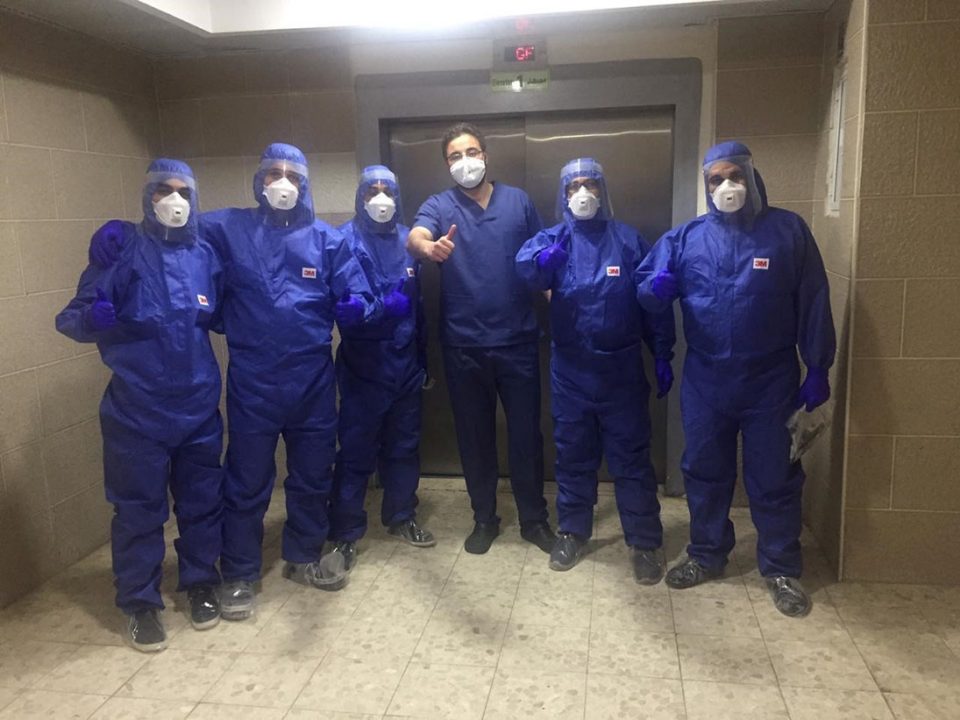On the night of April 13, the staff of Augusta Victoria Hospital (AVH) in Jerusalem discovered their first case of COVID-19. What followed was a series of measures to respond to the spread of the virus within the hospital, isolating patients and staff who had been exposed. As a result, within three weeks, the hospital had been declared free of COVID-19. Now that the virus is spreading locally in the community, there have been other infections, but through this first experience, the hospital learned important lessons to stop transmission and improve testing capacity. Hospital staff shared their passion for what they do in a recent article from the Lutheran World Federation.
AVH, owned and operated by the Lutheran World Federation, received funds from Lutheran Disaster Response to purchase medical equipment and build up its capacity to test and treat COVID-19 patients. Lutheran Disaster Response funding also provided Personal Protective Equipment that was critical to the hospital’s response. Leading up to the first case, AVH had taken a slew of preventative measures to protect staff and patients, such as setting up a triage tent on hospital grounds, taking the temperature of all employees before entry, screening patients for symptoms prior to arrival, and dividing the medical team into two 14-day shifts.
Throughout this experience, Moatassem Sayes, a doctor at AVH, documented the challenges the hospital faced. Read his abbreviated logbook below.
Introduction to the logbook
We have had losses and victories in our first experience with abating COVID-19 from within the walls of the hospital. I am compelled to share my experience so that we can look over this ordeal once more and be prepared to deal with it again if necessary. Our goal was to protect the medical team, our patients within the hospital, the community outside and our ability to continue providing medical services. Thanks be to God we have been able to achieve this. —Dr. Moatassem Sayes
The evening of Monday, April 13
A patient in the geriatric ward seemed to have had a fever for the past two days, which was the moment when we found ourselves in the midst of the COVID-19 outbreak.
We examined his medical history and looked up his medical contact. The patient’s son had visited him without fault for the past three years. After we called his son, it became clear he’d not visited his father for the past four days due to experiencing symptoms similar to those of COVID-19.
Based on these facts, we obtained a sample from the patient and tested it for COVID-19. After midnight, the results came in positive. This patient was the “index case,” the first case in AVH, to be followed soon after by two other patients in the geriatric ward. This was the moment our battle began.
Tuesday, April 14
A medical team of 62 people had worked their 14-day shift and left the hospital for their homes one day prior to the diagnosis of the COVID-19 cases in the hospital. We had to contact them before dawn Tuesday and inform them of the need to remain in home quarantine until further notification. All AVH staff who’d been in contact with the infected patients were tested for the virus. As we feared, two medical staff members tested positive.
We were shocked to find out the virus had spread beyond the geriatric ward. A nurse working in the operations department exhibited symptoms. The event was alarming because it meant the spread of the virus was larger than imagined.
Wednesday, April 15
As a follow-up, we researched the social circle of this particular nurse to trace the virus to those with whom he’d been in contact. Despite many challenges, we achieved this in optimum time. All staff results returned negative. Nevertheless, these staff members were quarantined. By closing this circle, we concluded that the infection spread from direct contact with a relative of the nurse who shares the same residence and works in the geriatric ward.
Evening of Wednesday, April 15
A nurse working in the chemotherapy ward tested positive, which shifted the scope and map of the viral contagion to include the entire hospital. The solutions were limited. Closing AVH would be the easiest solution, but the consequences would be catastrophic. We would lose the possibility of tracing the virus, and it would be disastrous for the families and friends of patients and staff.
Finally, Dr. Ali Sabateen drew a new map with a wider range, new names, containment measures and action plans to be initiated within the next day. Late at night, we contacted everyone who had been in contact with infected people to warn them they needed to quarantine and get tested for COVID-19 first thing in the morning.
Thursday, April 16
The test results of the previous medical staff all returned negative. By Thursday, we had closed down the contagion circle and there wasn’t a single case of infection, either of any members of the medical staff, or of any of the patients with whom the infected staff had been in contact.
Friday, April 17
One of the nurses who had recently arrived at the geriatric ward exhibited a high fever. Accordingly, he was placed under quarantine in an AVH-associated hotel with the rest of the nursing team. He was later admitted into the hospital’s COVID-19 ward, which had been set up in anticipation of such a scenario. We brought a new nursing team into the geriatric ward to avoid the possibility of infection.
In a courageous initiative, the medical nursing staff of the blood diseases department volunteered their services to fill the staffing gap in the geriatric ward. We set up a concentrated training course to prepare them for unpredictable variables that might come up, including the potential danger of contagion for COVID-19 and learning how to treat geriatric ward patients.
Saturday, April 18
This was the fifth day following the discovery of COVID-19 cases at AVH. New tests were completed for all the patients, with one returning positive. However, this did not come as a surprise because the entire geriatric ward was treated as if they were COVID-19 cases as a precautionary measure.
Sunday, April 19
All is under control; the circle of infection has been contained and regular work in the hospital has resumed.
Thursday, April 23
To sum up, this was the situation:
Medical staff infected: Eight nurses
Patients infected: Six from the geriatric ward
Medical staff under quarantine: 115
COVID-19 tests conducted at AVH: 138
Today new tests were conducted in the geriatric ward. All returned negative.
Final thoughts
I’m thankful for the hospital administration emergency committee that provided all the material, logistics and moral support for the infectious diseases department during this challenging period. I also thank the medical teams including doctors, nurses, laboratory technicians and services and Dr. Ali Sabateen for his indefatigable leadership.
It was fortunate that AVH was one of the first hospitals to have fought the battle against COVID-19. The hospital had the capacity, supplies, adequate preparation and exceptional leadership, as represented by our director Walid Nammour, who navigated us through our ordeal.
Translation by Aida Qleibo, Lutheran World Federation advocacy intern.





